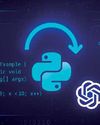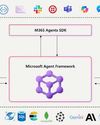يحاول ذهب - حر
The Why, What, and How of Containerisation
July 2025
|Open Source For You
Containerisation has revolutionised software development by offering lightweight, portable, and scalable solutions for application deployment. Containers empower teams to deploy applications faster and more reliably in diverse environments. Let's find out how and why they work so well.

In the modern era of software development, agility, scalability, and portability have become essential for building and deploying applications. Enter containerisation—a technology that has revolutionised the way developers package, deploy, and manage applications across various environments. From microservices architecture to DevOps pipelines, containerisation is now a cornerstone of cloud-native development.
Why containerisation?
The need for containerisation arises from the challenges developers and operations teams face when building, deploying, and maintaining software in diverse environments. Let's dive deeper into the reasons.
The “It works on my machine” problem: This age-old problem arises when code that runs perfectly on a developer’s local system fails in staging or production environments. This discrepancy is usually due to differences in:
- Operating system versions (e.g., Ubuntu 18.04 vs 22.04)
- Missing or different versions of dependencies (e.g., Python 3.6 vs 3.10)
- System libraries or tools
- Environment variables and configuration files
Containers fix this by encapsulating the application along with all its dependencies, libraries, and environment settings into a single, consistent unit. As a result, the containerised application behaves the same way—regardless of where it is deployed, be it a developer’s laptop, a test server, or a public cloud.
Example: A Flask web app containerised with Python 3.9 and specific libraries will run identically on all systems with Docker installed.
Slow and inefficient deployment with VMs: Traditional virtual machines (VMs) emulate entire operating systems. While VMs provide good isolation, they are resource-intensive:
- Require gigabytes of storage per instance
- Take minutes to boot
هذه القصة من طبعة July 2025 من Open Source For You.
اشترك في Magzter GOLD للوصول إلى آلاف القصص المتميزة المنسقة، وأكثر من 9000 مجلة وصحيفة.
هل أنت مشترك بالفعل؟ تسجيل الدخول
المزيد من القصص من Open Source For You

Open Source For You
The Role of Open Source in Building Modern Data Infrastructure
It's no secret that open source is emerging as the backbone of modern data infrastructure. Here’s a list of the core open source technologies used to deploy this infrastructure, along with some real-world examples and a brief on why open source matters.
3 mins
December 2025

Open Source For You
The Whispering Machines: How Open Source is Bringing Intelligence to the Tiniest Devices
Built on open source frameworks, TinyML is enabling complex machine learning models to run on the microcontrollers embedded in connected devices, bringing artificial intelligence to the very edge of the network.
3 mins
December 2025

Open Source For You
Setting Up Snort to Secure Your Network
Snort is a popular, open source intrusion detection system that monitors traffic in real time to detect malware. Here’s a detailed explanation of how to set it up on Ubuntu and test it by generating traffic from another system.
7 mins
December 2025

Open Source For You
When AI Meets DevOps to Build Self-Healing Systems
Traditional DevOps, with its rule-based automation, is struggling to work effectively in today’s complex tech world. But when combined with AlOps, it can lead to IT systems that predict failures and solve issues without human intervention.
7 mins
December 2025

Open Source For You
How to Automate Java Code Modernisation
This short guide illustrates that automating Java code modernisation with Python and OpenAI API is not just possible-it's remarkably effective.
5 mins
December 2025

Open Source For You
The Quest to Build a Quantum Computer
The road to large-scale quantum computing is long and hard, with incremental advances paving the way. But the destination is in sight.
12 mins
December 2025

Open Source For You
Job Opportunities: What's Hot in the Cloud Space?
If there's one field that refuses to slow down, it's cloud computing. Even as automation and AI reshape roles, cloud adoption continues to surge. From startups deploying microservices overnight to enterprises migrating decades of legacy systems, cloud remains the engine of digital transformation. For professionals, this means one thing: skills that live in the cloud won't come down anytime soon.
2 mins
December 2025

Open Source For You
Securing Client Identity with Post-Quantum Cryptography
Here's a quick tutorial on how to build a secure, real world client-server model that establishes client identity by using CRYSTALS-Dilithium, a post-quantum cryptography algorithm.
3 mins
December 2025

Open Source For You
Unlocking the Power of Multi-Agent Solutions with the Microsoft Agentic Framework
The Microsoft Agentic Framework is rapidly emerging as a cornerstone for developers, architects, and technology leaders seeking to build dynamic, intelligent systems powered by multiple collaborating agents. In an era where automation, distributed intelligence, and adaptive software are increasingly vital, this framework offers robust tools and features to accelerate the design and deployment of agent-based solutions.
6 mins
December 2025

Open Source For You
Apache Iceberg and Trino: Powering Data Lakehouse Architecture
Apache Iceberg is a cornerstone of any open data lakehouse, providing the transactional foundation upon which highly scalable and flexible analytics can flourish. Along with Trino, it can be used to build a robust, scalable, and high-performance data lakehouse.
4 mins
December 2025
Listen
Translate
Change font size
